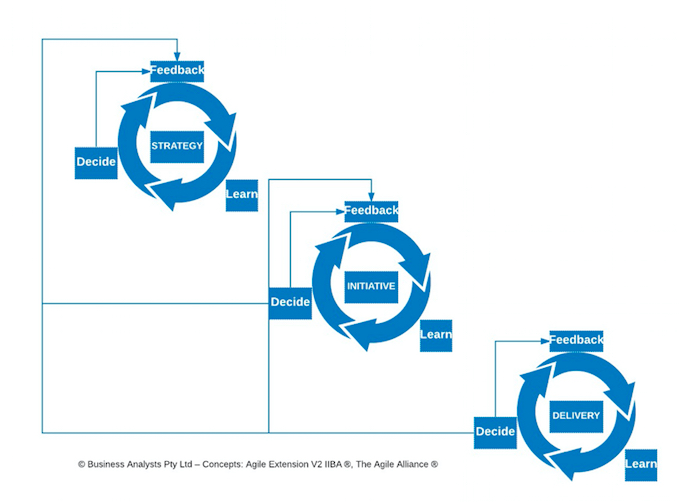A modern and innovative breed of systems delivery has gained significant momentum over the past one and a half decades, one that emphasises the ability to adapt to changing requirements, engage customer collaboration, and deliver a working software early and often. Agile was slow to start but quick to dominate, with most growth occurring in just the past five years.1 Evidently, Agile has now become the norm.
As organisations need to continually adjust to rapid changes from disruption and more customer-centric designs, even the organisations’ program governance and project management offices (PMOs) have also embraced the much-needed agility. The three planning horizons—Strategy, Initiative and Delivery—are key to driving Agile transformation across the organisation, and offer an apt framework for the shift in focus that occurs when moving between understanding the long-term strategic needs of the business and the immediate needs of a customer. 2

Strategy Horizon 3
According to former General Electric CEO Jack Welch, “an organisation’s ability to learn, and translate that learning into action rapidly, is the ultimate competitive advantage.” The goal of the Agile PMO working at the strategy horizon is to enable organisations to rapidly and effectively steer their products, services and initiatives without losing sight of business value, and to quickly redeploy available resources where they are needed the most.
The strategy horizon equips the Agile PMO with the ability to respond to rapid changes to customer expectations, the outside environment and the organisation. Further changes may emerge from analysing threats and opportunities, and learning from the frontline where the customers and various user personas are. Outcomes of the agile business analysis may result in starting a new initiative, or changing the resourcing, scope or success criteria of existing initiatives, or even cancelling an existing initiative that has become less relevant or less likely to succeed.
Initiative Horizon 4
The initiative horizon begins with the Agile PMO defining the needs to be satisfied, and concludes with identifying the aspects or components of the solution (aka product features) that will satisfy these needs.
As Peter Drucker, the founder of modern management, states, “There is nothing so useless as doing efficiently that which should not be done at all,” and the initiative horizon would attest to this fact. In this horizon, the Agile PMO gauges whether a solution is worth considering for implementation. The outcome of the agile business analysis is the collection of programs, projects and portfolio that is delivering the overarching strategy. When assessing solution options, various aspects are considered: (1) the shared understanding of the need to satisfy, (2) any assumptions made around the viability of a solution, (3) risks introduced from satisfying the need and the cost of mitigation, and (4) the constraints that may make some solution options nonviable.
Delivery Horizon 5
The outcomes of the agile business analysis from the strategy and initiative horizons cascade further down to the delivery horizon. In a nutshell, this horizon revolves around the Agile PMO confirming a shared understanding of the need, and whether the need has evolved or is no longer valid.
The Agile PMO working at the delivery horizon needs to ensure that requirements are mapped correctly to the business goals by identifying and prioritising a backlog of actions that will meet the need. The backlog items are then refined into implementable units of business value and elaborated into detail on a just-in-time basis.
Emphasis is on “just enough details” to avoid rework or waste from decomposing features into user stories too early, of which may change as new information comes to light. This backlog is continually re-prioritised, with items being flexibly removed and added at backlog refinement meetings or informally as needed. It is also imperative to establish a means of assessing outcomes, through immediate feedback from testing and customer evaluation, just to name a few.
However, note that the ‘buck doesn’t stop here’ in the delivery horizon. Sir Winston Churchill once said, “however beautiful the strategy, you should occasionally look at the results.” Learning from implemented stories is elevated back to its precursors, the initiative and strategy horizons, through open channels of regular and timely feedback.
One key aspect of a successful application of Agile PMO is that decisions are not made on stale data. In addition, unlike the strategy and initiative horizons that may have a medium-term outlook and a high-level view, the delivery horizon focuses on the specific aspects of the solution that are currently being developed or were delivered in the most recent increment.
Key Takeaway 6
Each horizon uses different perspectives, timing and levels of detail. The specific time spans for each horizon differ from organisation to organisation, but the concept of planning at multiple time horizons and different levels of granularity is central to Agile PMO business analysis.
1 Hewlett Packard Enterprise, Agile is the new normal (March 2017)
2, 3, 4, 5, 6 IIBA® and Agile Alliance Agile extension v2
